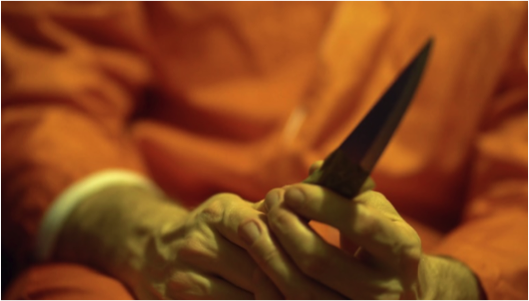 Imagine a spectrum that society uses to determine the social acceptability or criminality of a person’s actions. On one end, you have what society judges to be righteous, and on the other, you have what society judges to be deplorable. Between those two opposites, you have what society believes to be socially acceptable. By imagining it this way, we can see how people aren’t fully or indefinitely one or the other. People move back and forth, along the spectrum, and we want to argue that incarceration has an effect that on people that pulls them toward the deplorable side. Deplorable…........... …….……….……….*Socially Acceptable* …......... …….……….……….Righteous. |----------------------------------------------------|----------------------------------------------------| . ….... …….……….……….….... …….……….……….….... …….……….……….….... …….… … Before being charged with a crime, there is an implicit judgment that the person being charged falls somewhere in the socially acceptable range of the spectrum (a harsher judgment would place the person closer to the deplorable side). If someone is viewed as extremely righteous, it’s almost inconceivable that they’d be thought of as a suspect for a crime in the first place. Regardless of guilt, people on trial fall somewhere in the middle of the spectrum, so it is conceivable that the accused could’ve done it because they aren’t fully righteous. Prison is supposed to be place that rehabilitates people, pulling them toward the righteous side of the spectrum. Nevertheless, that doesn’t occur within penitentiary walls; the prison system actually has the opposite effect, pulling people toward the deplorable side of the spectrum. In high school, there were cliques like Jocks, Nerds, and The Rich Kids that defined your social status (being cool or not), but that idea doesn’t apply in The Big House. Being in prison deconstructs your idea of what being socially acceptable is, because it removes you from society and removes the social roles that previously made you who you were. Once you go to prison, you lose those parts of your identity because no one cares about what you did before you came to prison. It doesn’t matter if you were good at sports or if you came from a good/bad family. When someone first steps off the bus in iron shackles and is escorted into a single cell to be stripped, they are not only being stripped of their clothing, but they are also being stripped of all of their previous ideas and thoughts about their identity. Everyone thinks they are the Alpha when they first arrive, but that perspective is quickly replaced by their new reality. In his book, The Distressed Body: Rethinking Illness, Imprisonment, and Healing, Drew Leder discusses how the lifeworld of incarcerated people affects their perception. Commenting on lived time and lived space, he discusses how the existential displacement of imprisonment disrupts our methods of experience. Concluding the chapter with a section that examines the origin and initial purpose of the penitentiary, Leder says: “In Guenther’s words, Dickens recognized that ‘in practice this withdrawal from concrete social relations did not establish in prisoners the habits of reflective, penitent souls; rather it brought about a general demolition of their personhood, not an infliction of this or that part of the person, but a generalized incapacitation of their Being-in-the-World.’,” (180). Not only does incarceration reshape the personal identities of inmates, it also reshapes their social perceptions, allowing for people to have more violent inclinations. In this way, being in prison inherently causes the inmates to become more deplorable. Imprisonment reinforces antisocial behavior because even talking to the wrong person can violently backlash against you. The prison environment perpetuates a negative cycle that allows violence to be used as the means of determining social status because the fear of violence causes antisocial behavior, which leads to a loss of personhood, which makes committing acts of violence easier. In prison, the consequences of your actions have very different effects, and even words can get you killed. For example, if you ask someone for a honey bun, and you tell them that you’ll give them another on State Day, but when the day comes and you don’t have it, that means you lied and will never be trusted again. That’s the easy part of this equation. Now when you go to the restroom, you’ll be standing at the urinal and out of nowhere you’re getting punched in the side of the head. Violence is the tool used for resolving disputes in prison because a lot of inmates no longer have a sense of what is socially acceptable or don’t care enough to acknowledge the fact that those kinds of actions are normally thought of as deplorable. Physical violence reverses the order of social status in the penitentiary when compared to outside society. Normally violence is considered a deplorable act, something that would lower your social status, but in prison, violence is used to determine where you fall in the hierarchy. Other inmates don’t care about what you did or who you were before you came to prison, they only care about the amount of violence you are willing to display. When righteous people were given the most social status, the gauge was social acceptability, but with the destruction of that idea, physical violence replaces it, causing the most violent people to gain the highest social status. The more proficient you are at displaying violence, the more respect you garner. After all, respect is not given - it is always earned, the hard-way. Because the idea of social acceptability is nonexistent, there aren’t rules that prevent inmates from doing whatever they want. Think about it- whoever said “no” to the bully on the playground; bullies do as they please, until someone meaner and nastier comes along to scare them off, because, like many prisoners, they operate under the law of violence instead of the unwritten laws of socially acceptable behavior. The law of violence, that is the only Law that applies in here. In order to battle the pattern of criminalistic behavior that is forced upon you, you can’t allow violence to overtake and corrupt your moral code of conduct. By choosing not to act violently, you can reclaim the idea of social acceptability; forever changing your perspective of the world. The destruction of identity, the antisocial nature of the prison, and the prevalence of violence are all ways of dehumanizing inmates, but there are more factors that cause prisoners to be pulled toward the deplorable end of the spectrum. Day in and day out, you are constantly around others who talk non-stop of their crimes, and before you know it, you start to analyze their mistakes and begin to critique them as if you were going to go out and commit the same crime, but only to do it better. Leder comments on Charles Dickens use of Plato’s cave from the Republic as a metaphor for a prison cell by saying:
“Though metaphorical, it seems an apt image of many a prison. Educators, counselors, and others who might bring “light” from the outside world are often woefully absent. The inmates are left primarily amongst “shadows” - the society of often contemptuous authorities, other criminals, and personal memories of a previous misspent life. For most, there are few activities of a positive nature to pursue. The entire environment reinforces their identity as a “criminal,” taking an act from their life, perhaps the worst thing they have ever done, and saying “this is who you are.” Not surprisingly, on release from the cave, the inmate is often poorly equipped to reenter the broader society,” (181). For inmates, topics of conversation often revolve around criminality. Constantly being subjected to those ideas keeps them fresh in your mind, and it gets your imagination moving in the wrong direction. The prison environment doesn’t present positive opportunities for inmates, and in many ways it reinforces criminal behavior. Prisoners are denied access to educational resources and the necessary psychological therapy that would allow them to improve themselves, making it difficult to move toward the righteous side of the spectrum. Prison environments reinforce criminalistic behaviors because it inherently destroys your identity, sense of self, and your social conceptions. In society outside of the carceral system uses a spectrum that contrasts the righteous with the deplorable in order to determine what is socially acceptable. Because prisoners often use violence as a means of creating a social hierarchy, they don’t follow the normal conceptions of socially acceptable behavior, which reinforces further the criminalistic patterns they are forced into. This process of being pulling toward the deplorable end of the spectrum is, by nature, the opposite of what rehabilitation is, so therefore, rehabilitation doesn’t really exist or operate in our current prison system. References images: Jock => https://www.linkedin.com/pulse/heres-where-your-online-hiring-efforts-go-horribly-wrong-leigh-davis Prisoner behind bars => https://www.theguardian.com/society/2016/nov/02/prison-violence-crisis-talks-elizabeth-truss-union-calls-off-protests Knife/Shank => https://d2v9y0dukr6mq2.cloudfront.net/video/thumbnail/A0c7kEP/videoblocks-male-prisoner-adult-white-caucasian-holding-a-knife-shank-weapon-contraband-violent-gang-member-orange-jumpsuit-violent-young-offender-20s-30s-serving-time-in-county-jail-convict-in-prison_r7gfugwce_thumbnail-full01.png
0 Comments
Leave a Reply. |
AuthorI'm a philosopher, a writer, a thinker, an Inside-Out Prison Exchange Instructor. I do a lot of these on the road as part of recognizing the value of philosophy as a public practice. Archives
October 2018
Categories |
Wittenberg
|
Buy Now |


 RSS Feed
RSS Feed